The AMD Ryzen 9 3950X Review: 16 Cores on 7nm with PCIe 4.0
by Dr. Ian Cutress on November 14, 2019 9:00 AM ESTGaming: Grand Theft Auto V
The highly anticipated iteration of the Grand Theft Auto franchise hit the shelves on April 14th 2015, with both AMD and NVIDIA in tow to help optimize the title. GTA doesn’t provide graphical presets, but opens up the options to users and extends the boundaries by pushing even the hardest systems to the limit using Rockstar’s Advanced Game Engine under DirectX 11. Whether the user is flying high in the mountains with long draw distances or dealing with assorted trash in the city, when cranked up to maximum it creates stunning visuals but hard work for both the CPU and the GPU.
For our test we have scripted a version of the in-game benchmark. The in-game benchmark consists of five scenarios: four short panning shots with varying lighting and weather effects, and a fifth action sequence that lasts around 90 seconds. We use only the final part of the benchmark, which combines a flight scene in a jet followed by an inner city drive-by through several intersections followed by ramming a tanker that explodes, causing other cars to explode as well. This is a mix of distance rendering followed by a detailed near-rendering action sequence, and the title thankfully spits out frame time data.
There are no presets for the graphics options on GTA, allowing the user to adjust options such as population density and distance scaling on sliders, but others such as texture/shadow/shader/water quality from Low to Very High. Other options include MSAA, soft shadows, post effects, shadow resolution and extended draw distance options. There is a handy option at the top which shows how much video memory the options are expected to consume, with obvious repercussions if a user requests more video memory than is present on the card (although there’s no obvious indication if you have a low end GPU with lots of GPU memory, like an R7 240 4GB).
All of our benchmark results can also be found in our benchmark engine, Bench.
| AnandTech | IGP | Low | Medium | High |
| Average FPS | 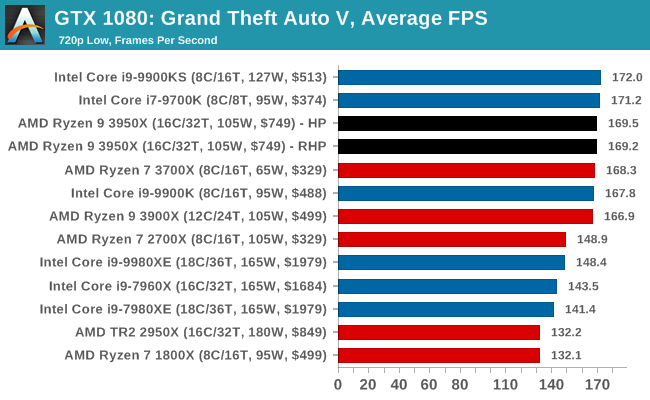 |
 |
 |
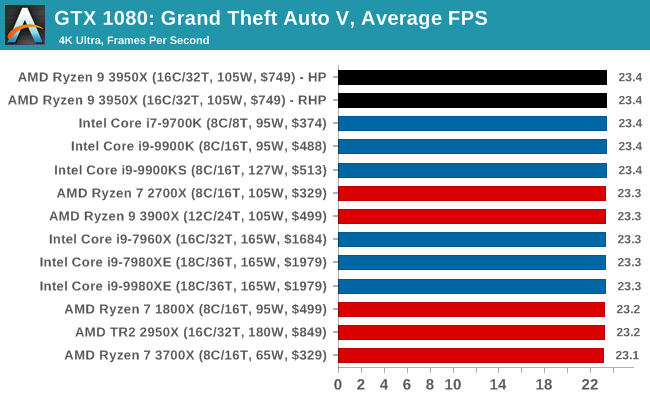 |
| 95th Percentile | 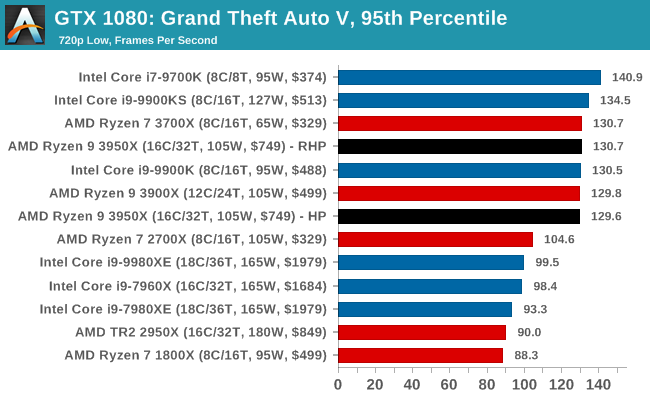 |
 |
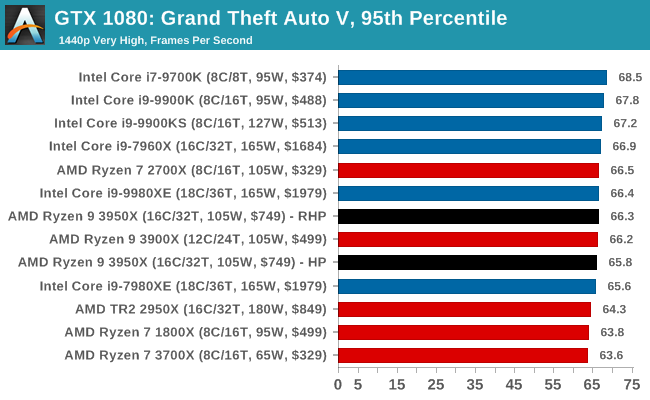 |
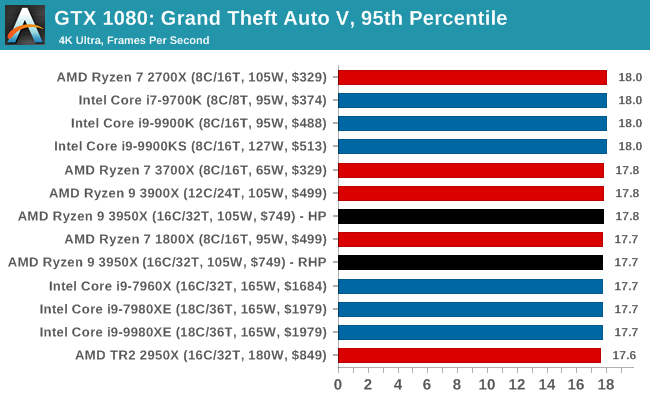 |












206 Comments
View All Comments
529th - Thursday, November 14, 2019 - link
There is also a Windows power plan called 'Ultimate' What's better for AMD Ryzen CPUs, RHP or the plain old Windows Ultimate power plan?TallestJon96 - Thursday, November 14, 2019 - link
Stop testing with a GTX 1080. It is almost 4 years old, and there are half a dozen cards that are significantly faster than it now. Anandtech's gaming benchmarks are behind the times and not very useful because of this.Hadenas - Thursday, November 14, 2019 - link
Please start using either a 2080 or 2080ti for gaming test. Nobody would use a 1080 with the 3950x.Satyyri1972 - Wednesday, November 20, 2019 - link
I amCHADBOGA - Thursday, November 14, 2019 - link
Always wonderful to see the worst gaming setup for benchmarking, anywhere on the internet.SanX - Friday, November 15, 2019 - link
where is source code for 3D particle movement? In the link above are only exe files and it is unclear what the test is doing. May be it is doing just one single operation in cache over and over again.lenghui - Friday, November 15, 2019 - link
I am guilty of not reading the entire article, and will definitely come back again to read it all. At a glance, I love how AnandTech includes the prices so that I don't have to keep looking it up. However, I am still unable to figure out what RHP vs HP means half way through the charts. I wish there is a simple legend to explain that. I tried looking around and didn't find any references. Again, I am guilty of not reading it all, just saying it would be super convenient when I want to look at the results in a crunch.lenghui - Friday, November 15, 2019 - link
Thanks for the review, Ian. I finally got to the last page and saw what HP and RHP means, but my earlier comment still stand.To me personally, I never ran Ryzen Master since the first two days I built my Ryzen machine because Ryzen Master can only launch when Virtualization Based Security (VBS) is disabled. This is really lame on AMD part. I built this 8 core-16 thread machine to run my VMs, but I can't run Ryzen Master :( Other than that, I love my build.
GreenReaper - Friday, November 15, 2019 - link
This piece is a great endorsement of the 3900X, or the 3700X for desktop tasks. Why pay more?You profit from being willing to accept imperfect cores - and let's not forget a cooler is thrown in.
Testing for the latest issues will be fun; not only do you have before/after microcode patches, you have before/after the program under testing was recompiled to avoid the situation requiring patching.
Sailor23M - Friday, November 15, 2019 - link
3700X missing in the price/perf graph.